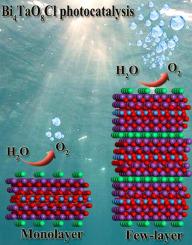当前位置:
X-MOL 学术
›
Appl. Surf. Sci.
›
论文详情
Our official English website, www.x-mol.net, welcomes your
feedback! (Note: you will need to create a separate account there.)
Exploring the Thickness Dependent Photocatalytic Oxygen Evolution Performance for Bi4TaO8Cl Two-Dimensional Semiconductor
Applied Surface Science ( IF 6.3 ) Pub Date : 2021-02-01 , DOI: 10.1016/j.apsusc.2020.148193 Yingwei Yi , Chuye Quan , Fei Long , Yong Pu , Xing'ao Li
Applied Surface Science ( IF 6.3 ) Pub Date : 2021-02-01 , DOI: 10.1016/j.apsusc.2020.148193 Yingwei Yi , Chuye Quan , Fei Long , Yong Pu , Xing'ao Li

|
Abstract The utilization of solar energy for water splitting has great potential to alleviate the worsening environmental issues. Two-dimensional (2D) materials, possessing tunable band gap, large surface area with more active sites, and short photogenerated carriers migrating distance, have attracted massive research interests as promising photocatalysts. In the water splitting reaction, compared with the hydrogen evolution reaction, the four elementary steps of oxygen evolution reaction (OER) is a complex and difficult reaction. Among 2D materials, Bi4TaO8Cl exhibits great potential for the OER. It is worth noting that the thicknesses of 2D materials is a significant factor for modifying physicochemical properties. However, the thickness dependence of OER performance remains unclear in Bi4TaO8Cl. Here, we systematically studied the effects of thicknesses on photocatalytic performance. Interestingly, we found that the few-layer Bi4TaO8Cl possesses more remarkable photocatalytic properties than monolayer Bi4TaO8Cl deriving from interlayer coupling effect. Compared with monolayer Bi4TaO8Cl, the few-layer exhibits broader range of light absorption accompanied with larger transition dipole moment, stronger reduction potential to drive the OER, and lower recombination probability of photogenerated electron and hole. The interlayer coupling interaction improves the photocatalytic properties, which promotes the progress of 2D material at photocatalytic water splitting reaction.
中文翻译:

探索 Bi4TaO8Cl 二维半导体的厚度依赖性光催化析氧性能
摘要 利用太阳能分解水具有缓解日益恶化的环境问题的巨大潜力。二维(2D)材料具有可调带隙、大表面积和更多活性位点以及光生载流子迁移距离短等优点,作为有前途的光催化剂引起了广泛的研究兴趣。在水分解反应中,与析氢反应相比,析氧反应(OER)的四个基本步骤是一个复杂而困难的反应。在二维材料中,Bi4TaO8Cl 具有巨大的 OER 潜力。值得注意的是,二维材料的厚度是改变物理化学性质的重要因素。然而,Bi4TaO8Cl 中 OER 性能的厚度依赖性仍不清楚。这里,我们系统地研究了厚度对光催化性能的影响。有趣的是,我们发现由于层间耦合效应,少层 Bi4TaO8Cl 比单层 Bi4TaO8Cl 具有更显着的光催化性能。与单层 Bi4TaO8Cl 相比,少层表现出更宽的光吸收范围,伴随着更大的跃迁偶极矩,更强的还原电位驱动 OER,以及更低的光生电子和空穴复合概率。层间耦合相互作用提高了光催化性能,促进了二维材料在光催化分解水反应中的进展。我们发现,由于层间耦合效应,少层 Bi4TaO8Cl 比单层 Bi4TaO8Cl 具有更显着的光催化性能。与单层 Bi4TaO8Cl 相比,少层表现出更宽的光吸收范围,伴随着更大的跃迁偶极矩,更强的还原电位驱动 OER,以及更低的光生电子和空穴复合概率。层间耦合相互作用提高了光催化性能,促进了二维材料在光催化分解水反应中的进展。我们发现,由于层间耦合效应,少层 Bi4TaO8Cl 比单层 Bi4TaO8Cl 具有更显着的光催化性能。与单层 Bi4TaO8Cl 相比,少层表现出更宽的光吸收范围,伴随着更大的跃迁偶极矩,更强的还原电位驱动 OER,以及更低的光生电子和空穴复合概率。层间耦合相互作用提高了光催化性能,促进了二维材料在光催化分解水反应中的进展。并且光生电子和空穴的复合概率较低。层间耦合相互作用提高了光催化性能,促进了二维材料在光催化分解水反应中的进展。并且光生电子和空穴的复合概率较低。层间耦合相互作用提高了光催化性能,促进了二维材料在光催化分解水反应中的进展。
更新日期:2021-02-01
中文翻译:

探索 Bi4TaO8Cl 二维半导体的厚度依赖性光催化析氧性能
摘要 利用太阳能分解水具有缓解日益恶化的环境问题的巨大潜力。二维(2D)材料具有可调带隙、大表面积和更多活性位点以及光生载流子迁移距离短等优点,作为有前途的光催化剂引起了广泛的研究兴趣。在水分解反应中,与析氢反应相比,析氧反应(OER)的四个基本步骤是一个复杂而困难的反应。在二维材料中,Bi4TaO8Cl 具有巨大的 OER 潜力。值得注意的是,二维材料的厚度是改变物理化学性质的重要因素。然而,Bi4TaO8Cl 中 OER 性能的厚度依赖性仍不清楚。这里,我们系统地研究了厚度对光催化性能的影响。有趣的是,我们发现由于层间耦合效应,少层 Bi4TaO8Cl 比单层 Bi4TaO8Cl 具有更显着的光催化性能。与单层 Bi4TaO8Cl 相比,少层表现出更宽的光吸收范围,伴随着更大的跃迁偶极矩,更强的还原电位驱动 OER,以及更低的光生电子和空穴复合概率。层间耦合相互作用提高了光催化性能,促进了二维材料在光催化分解水反应中的进展。我们发现,由于层间耦合效应,少层 Bi4TaO8Cl 比单层 Bi4TaO8Cl 具有更显着的光催化性能。与单层 Bi4TaO8Cl 相比,少层表现出更宽的光吸收范围,伴随着更大的跃迁偶极矩,更强的还原电位驱动 OER,以及更低的光生电子和空穴复合概率。层间耦合相互作用提高了光催化性能,促进了二维材料在光催化分解水反应中的进展。我们发现,由于层间耦合效应,少层 Bi4TaO8Cl 比单层 Bi4TaO8Cl 具有更显着的光催化性能。与单层 Bi4TaO8Cl 相比,少层表现出更宽的光吸收范围,伴随着更大的跃迁偶极矩,更强的还原电位驱动 OER,以及更低的光生电子和空穴复合概率。层间耦合相互作用提高了光催化性能,促进了二维材料在光催化分解水反应中的进展。并且光生电子和空穴的复合概率较低。层间耦合相互作用提高了光催化性能,促进了二维材料在光催化分解水反应中的进展。并且光生电子和空穴的复合概率较低。层间耦合相互作用提高了光催化性能,促进了二维材料在光催化分解水反应中的进展。











































 京公网安备 11010802027423号
京公网安备 11010802027423号